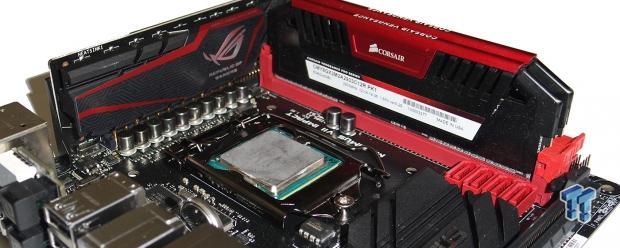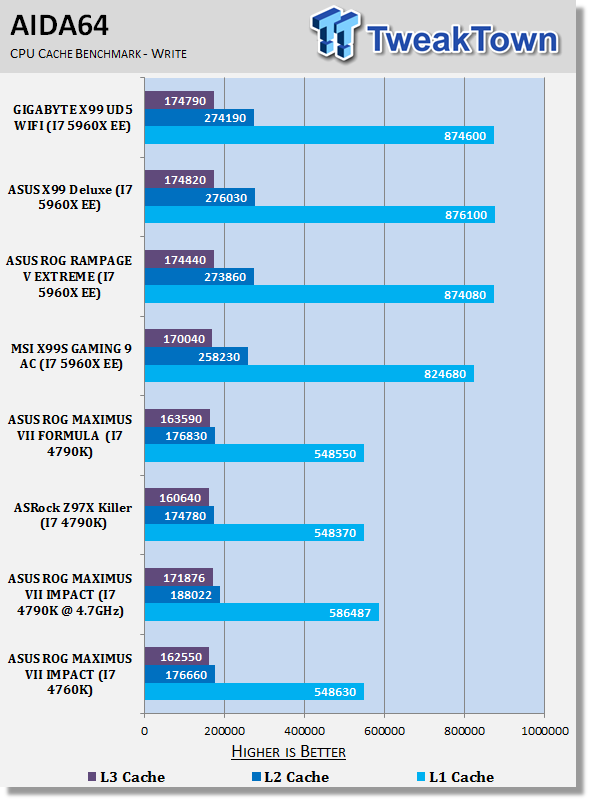
The Bottom Line
Introduction and Package
Introduction of the ASUS ROG MAXIMUS VII IMPACT

Over the past few months, a lot of the focus when it comes to motherboards and video cards has been on the higher-end market with the X99 chipset. The X99 chipset brought with it a new crop of high-end CPUs and DDR4, while the new Maxwell video card series from NVIDIA saw the GTX 970 and GTX 980. The GTX 970 and GTX 980 are high-end models, and although they are priced extremely well, they are still quite expensive for many people.
Today we're looking at a motherboard from ASUS that uses the impressive Z97 chipset. Using DDR3, and with a large range of processor options available, the cost of getting into a Z97 build is much more attractive than the cost associated with the X99 platform.
The particular board Z97 board we're looking at today comes from ASUS, and is part of the popular Republic of Gamers (ROG) series. The Maximus VII Impact is a Mini-ITX motherboard. This is a platform that we probably won't see on the new X99 chipset due to the fact that installing four DIMM slots for the quad channel memory support is going to be nearly impossible.
So, if you're looking for a motherboard that carries the more cost-effective Z97 chipset, while also being extremely small, then this might be just the motherboard you're looking for. Now, let's start with the package before moving forward to see just how much ASUS could pack into this small package.
Package - What comes inside the box


As you can see, we don't have a whole lot happening on the front of the box; because the box is small, there just isn't a whole lot of room. With that said, though, there is a ROG logo at the top, the Maximus VII Impact name in the middle, and a couple of logos across the bottom. After flipping the top open, you can see ASUS gives us a rundown on some of the main features offered.
You can see the big feature marketed here is the improved audio, which comes via the Supreme FX Impact II technology. The improved audio technology also brings Sonic Studio, a one-click virtual surround sound technology; Sonic SoundStage, which brings hardware level audio profiles; and the Sonic SenseAmp, which is able to auto-detect headphones and instantly optimize the amp level to bring the highest quality of sound. Across the bottom, you can see the Impact Power II feature, which brings improved power stability and performance, which is normally only reserved for larger boards.


On the other half of the box, you can see the interface features, which includes KeyBot, a feature that lets you adjust settings like CPU speeds and XMP profiles on-the-fly. We've also got the mPCIe Combo IV card, which provides 802.11ac, Bluetooth 4.0, mPCIe, and PCIe Gen3 x4 M.2. We'll take a closer look at this technology on the next page. We finish up across the bottom with the networking features that include Intel Ethernet, LANGuard, and GameFirst III, all of which help improve your networking experience.
Turning over to the back of the box, you can see some of the main features are highlighted again, including the SupremeFX Impact II, mPCIe Combo IV, Impact Power II, and Impact Control II. Along with this, you can see the main specifications of the board, and get a look at the rear I/O. We will take a closer look at all of this in just a moment.

Inside of the package, you can see all of the normal inclusions, starting with the user guide and driver CD. Along with these, we've got the SATA cable labels which often go with the four included SATA II cables, and our I/O back plate protector.

Finally, we finish up with a lot of the features that you saw mentioned on the box. Starting from the top left, we've got the SurpremeFX Impact II, a card that brings some extra fan headers, the mPCIe Combo IV card we mentioned earlier, and our Wi-Fi antenna to round things off. Considering the small size of the board and box, we've got quite a lot going on.
PRICING: You can find the ASUS ROG Maximus VII Impact for sale below. The prices listed are valid at the time of writing, but can change at any time. Click the link to see the very latest pricing for the best deal.
United States: The ASUS ROG Maximus VII Impact retails for $229.99 at Amazon.
Canada: The ASUS ROG Maximus VII Impact retails for CDN$287.47 at Amazon Canada.
Motherboard Details
Close up with the ASUS ROG MAXIMUS VII IMPACT

Looking at the board, you can immediately see that there's just not a whole lot happening on the board due to the small footprint associated with the Mini-ITX format. Let's move in a bit closer, and see exactly what we're dealing with today.


Across the bottom, you can see the single expansion slot is a PCIe x16 slot, which is very standard. Just above this slot, and to the left, you can see where our mPCIe Combo IV card is installed. Around the corner, you can see our two DDR3 DIMM slots that support up to 16GB of DDR3 with speeds ranging from 1333MHz DDR to 3300MHz DDR via overclocking.
Sitting above our two DIMM slots, we've got four SATA III ports, all of which run off the Intel Z97 chipset. Across the bottom, you can see a USB 3.0 header on the left, a fan header next to that, and a start and reset button. Finally, we finish off with our power connectors, which include the standard 24-pin ATX power connector, and an eight-pin CPU power connector. The eight-pin connector is a nice addition, as we normally see a four-pin connector included.

Looking at the CPU area, you can see it's pretty clean, which is quite cool considering how small the board is, and how much ASUS is offering on it. A big part of this is owed to the Impact Power II setup, which sees a vertical design to offer more room, and more power to the tiny board.

We will finish up with the I/O, which has a whole lot going on. Starting from the left, we've got a HDMI and DisplayPort connector, along with a single Optical out port, which runs off of the SurpremeFX Impact II Eight-Channel HD Audio Codec. Next to that, we've got the Impact Control II port, which brings with it a LED Debug Reader, ROG Connect, clear CMOS button, and the out sound and KeyBot buttons.
We've got a total of eight USB ports, with four being USB 2.0, and the other four being USB 3.0. Finally, we have a PS/2 Combo port and Gigabit LAN port running off the Intel I218V controller.
BIOS Images and Information



As always, if you're heading into the BIOS, then chances are you'll want to do some overclocking. In this case, you'll want to head straight into the Extreme Tweaker section, which is the screen you're greeted with when entering the BIOS. Here, you've got all of the OC options you'd expect, and more.
If you want to do some overclocking, but you're not quite sure where to start, you can use the Ai Overclock Tuner feature of the Overclocking Presets offered for easy overclocking.






Heading through the rest of the BIOS, you can see all of the other features that you're used to seeing, including the Tool area, which brings with it EZ Flash 2 Utility, OC Profiles, OC Panel Configure, and more. With so many options offered, the BIOS is all very typical ROG. The good news is that, as always, ASUS does a fantastic job of catering to people new to the BIOS, and those who are extremely familiar.
Test System Setup and Overclocking

We would like to thank the following companies for supplying and supporting us with our test system hardware and equipment: Intel, ASUS, MSI, Western Digital, MemoRight, and Corsair.
We've got a bunch of boards in our graphs today, and a lot of them do revolve around the higher-end X99 chipset. The X99 boards in our graphs include the MSI X99S Gaming 9, ASUS ROG Rampage V Extreme, ASUS X99 Deluxe, and GIGABTYE X99-UD5 WIFI, all of which are using the Intel i7 5960X EE CPU.
As for Z97 based boards, we've got the ASRock Z97X Killer, and the ASUS ROG Maximus VII Formula. These will all be sitting alongside our ASUS ROG Maximus VII Impact running at stock and overclocked via our Intel i7 4790K processor.

Heading into the BIOS, we start to mess around with our voltages and multiplier. With little effort, we ended up with our CPU running at 4700MHz via a 47x multiplier, and a 100 BCLK. This isn't a bad overclock, and should provide a nice little performance boost over the stock speed of the i7 4790K.
CPU & System Benchmarks
CPU Test - HyperPi 0.99
Version and / or Patch Used: 0.99

CPU Test - AIDA64
Version and / or Patch Used: 1.00.1035BETA


Starting off with our CPU tests, you can see performance is pretty solid across the board, lining up with our other Z97 offerings here. When we throw overclocking into the mix, you can see we get a bit of a performance boost thanks to that extra couple of hundred MHz offered.
System Test - PCMark 8
Version and / or Patch Used: 1.04

System Test - MediaEspresso
Version and / or Patch Used: 6.5

System performance at stock is pretty standard, and the numbers are quite similar between all of our Z97 boards here. Looking at overclocking performance, you can see a bit of a boost, but overall, it's not too strong since the i7 4790K just isn't as good of an overclocker as the i7 4770K.
USB 2.0, USB 3.0, & SSD Benchmarks
USB Test - AIDA64
Version and / or Patch Used: 1.70.1400


Looking at USB 2.0 and 3.0 performance, you can see the numbers across the board are pretty standard, and sit in the middle to top end of the pack.
SSD Test - AIDA64
Version and / or Patch Used: v4.30.2900

SSD Test - PCMark 8
Version and / or Patch Used: 2.0.191

SSD Test - HD Tune Pro
Version and / or Patch Used: 5.50

Looking at SSD performance, you can see the ASUS ROG Maximus VII Impact performs very well under AIDA64 and HD Tune Pro, with very impressive numbers being shown. Under AIDA64, you can see that the ASUS offering easily sits ahead of the other Z79 options here.
Memory & Gaming Benchmarks
Memory Test - AIDA64
Version and / or Patch Used: 1.00.1035BETA

Looking at copy and read performance, you can see the ASUS ROG Maximus VII Impact lines up with our other Z97 options. Write performance, on the other hand, is very strong, and comes clear ahead of the other options here.
Gaming Test - 3DMark FireStrike
Version and / or Patch Used: Latest Steam Update

Gaming Test - Sleeping Dogs
Version and / or Patch Used: Latest Steam Update

Under 3DMark, we can see gaming performance is a little stronger on the ASUS ROG Maximus VII Impact, while Sleeping Dogs numbers are in line with the ASRock Z97X Killer, which manages to come out ahead by a decent chunk when compared to the ASUS Maximus VII Formula.
When it comes to overclocking, we can see a bit of a performance boost at the lower resolutions, while no real change shows in the Extreme preset under 3DMark, and at 2560 x 1600 under Sleeping Dogs.
Temperature & Power Testing
Power Consumption Test

Power draw on the ASUS ROG Maximus VII Impact isn't bad, and the board sits in the middle of the pack. With overclocking thrown into the mix, you can see that the idle number jumps slightly, while the load number comes in at just over 400 watts. For a setup like this, we'd recommend a power supply around the 550 watts mark.
Core Temperature Test

At stock, our i7 4790K is running a bit warmer on this tiny board when compared to our other options here. As for overclocking, though, you can see that the overall temperature jumps only slightly. Overall, while the numbers are warm, are still at a level that is fine.
Pricing, Availability, and Final Thoughts
Sitting at around the mid $200 price point, this isn't a cheap Z97 motherboard, especially when you consider the size of it. The simple fact is that ASUS design these boards so well that they were able to pack many features onto such a small PCB - so many more features than you would even think is possible.
When it comes down to it, apart from a pair of DIMM slots, and the lack of extra expansion ports, you really do see everything and more. SurpremeFX provides awesome audio quality, and thanks to the mPCIe combo card, we see M.2, 802.11ac Wi-Fi networking, and Bluetooth. The Impact Control II board brings us the LED Debug Reader, along with a clear CMOS button, while another card provides some extra fan headers to the board.
Everything about this board is bigger than you'd expect. From the information on the box, to the bundle that's included, all the way to the amount of features that offered thanks to some extra cards, and a truly awesome layout that goes vertical in a number of areas.
Anytime you're talking about a Mini-ITX motherboard, the simple fact is that if you're not after a tiny motherboard like this, then it's simply a waste of money. While you get so much on this board for the money, if you're able to use a larger motherboard, then something like the ASUS Maximus VII Hero might be a better option that comes in around the $200 mark.
If you've got the money, and you want to build a Mini-ITX system, then this is just a truly fantastic motherboard. As we've said so many times already, this board packs so much more than you would think is possible. On the other hand, if you're able to use something that's a bit larger, one of the other ASUS ROG options may be a better choice.
PRICING: You can find the ASUS ROG Maximus VII Impact for sale below. The prices listed are valid at the time of writing, but can change at any time. Click the link to see the very latest pricing for the best deal.
United States: The ASUS ROG Maximus VII Impact retails for $229.99 at Amazon.
Canada: The ASUS ROG Maximus VII Impact retails for CDN$287.47 at Amazon Canada.
